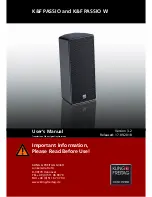
4
F. REV/AUX –
Adjusts the amount of signal sent to the
internal Reverb processor, and to the Rev/Aux output
jack. In the full left position the control is effectively off.
Care should be taken to set the Reverb return master
control to a middle position or above, before adjusting
levels from the individual channels. When the
reverb/auxiliary mix is set, overall levels of reverb can be
adjusted at the master control.
G. BAL –
The balance control features a notched
position indicator and adjusts the perceived “position”
of the mono signal from the input within the stereo field
created by the two speakers. Full Left or Right rotation
of this control sends the signal to the that channel only,
with no signal sent to the other. The center position
sends the same amount of signal to both speakers.
H & I. MASTER VOLUME LEVEL CONTROLS –
The
Left and Right Master Volume Controls adjust the
output volume of the PD-150. The Master controls
feature notched position indicators. For the majority of
applications the Passport system has been balanced to
operate with these controls at their notched 12 o’clock
positions. In situations where more volume is required
the master controls can provide an additional 6 dB of
gain when turned to the right of the center position.
Set the system up in the normal manner and adjust
levels as necessary. Raise the master volume controls
beyond their 12 o’clock positions only after increasing
the individual channel level controls.
Passport’s internal amplifiers have on-board processing
designed to optimize the system’s performance when
used with the custom designed PD-150 speakers.
J. MASTER REVERB –
Adjusts the amount of reverb
signal level sent to the mix or output. Rotating the knob
clockwise increases the reverb signal sent to the main
mix. When the knob is in its full counterclockwise
position, there is no reverb heard in the mix.
K. SYSTEM EQ –
Adjusts the overall amount of
frequency increase or decrease on the Passport.
Rotating the knob counterclockwise increases the bass
frequency response while simultaneously decreasing
the high frequency response. Likewise, rotating the
knob clockwise increases the high frequency response
while simultaneously decreasing the bass frequency
response. When the system EQ control is set at its
notched or straight up position, the channel response is
“flat” with no frequencies increased or decreased. To
set the System EQ, start with this control in the 12
o’clock (flat) position. Simply turn the control until things
sound good!
You will notice that the input jacks and channel
controls are color coded. This is done to easily
identify which set of controls is associated with
which input connections.
A. LINE / MIC SWITCH –
This
switch allows you to select gain
levels for either a microphone or
line level source. When the
switch is in the line position, the
input level is optimized for items
such as guitars, keyboards,
drum machines, outboard
effects, etc. When the switch is
in the mic position, the input
level is optimized for most
commonly used microphones.
No harm will come to the
circuitry if the switch is in the
wrong position. However, for optimum performance, be
sure to use the mic position when a microphone is
plugged into the respective channel and the line
position when an item using a line level signal is used.
M. MIC INPUT JACK –
Plug your microphone in here.
This three pin XLR balanced female input connector is
intended for input signals from low impedance
microphones.
N. LINE INPUT JACK –
Plug your instrument in here.
This 1/4 inch balanced input jack suited for use with
items having a line level output such as high impedance
microphones, keyboards, drum machines, outboard
effects, etc. It accepts both balanced and unbalanced
cables.
O. AUX LINE INPUT (Ch. 3) –
Input 3 features a pair of
RCA input connectors that allow an additional line level
stereo source to be input to the system. These
connectors SUM, or add, the two input signals together
(mono) and send them to the mix in exactly the same
way as the normal Line inputs. Note: These connectors
are set at a constant "line level" are not effected by the
Mic/Line "gain" select switch.
MASTER CONTROL FUNCTIONS
MIC / LINE / STEREO INPUTS







































